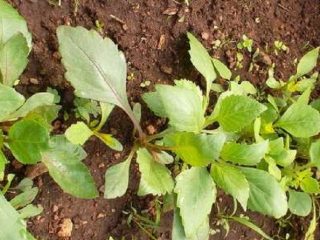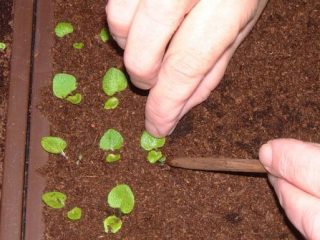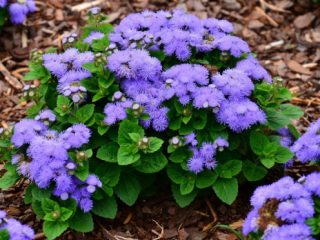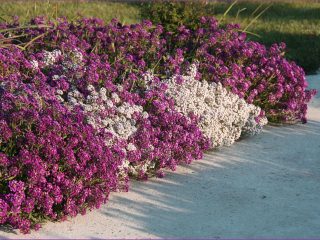Content
Petunia supercascade is a type of ornamental plant that is particularly lush. It has very long stems, which are densely covered with buds during the flowering period.
What does super cascade petunia look like?
Petunia supercascade is an annual plant belonging to the hanging category. It differs from most ordinary varieties in its dimensions.
The shoots of the crop are strong, thick and flexible, reach 2 m in length, retain their given shape well and do not require the installation of trellises and supports. The leaves of the plant are oval, pointed at the tips, with slight pubescence at the top. The annual buds are bell-shaped and can be white, purple, blue, lilac or two-colored. During the decorative period, they appear on the stems very abundantly; one flower is formed in each axil.
The shoots of super-cascade petunia, like those of cascade petunia, first grow vertically upward and then fall down.The crop is most often grown in flowerpots, tall pots and hanging flowerpots, but sometimes it is also planted in open ground. The plant looks good as part of alpine slides.

Supercascade petunia blooms most often until mid-autumn
Advantages and disadvantages
The popularity of the annual is due to its many advantages. The benefits of the plant include:
- long flowering - buds remain on shoots from early summer until late autumn;
- endurance - in general, the crop can withstand unfavorable conditions well and is not afraid of slight cold snaps and rains;
- unpretentiousness - during cultivation, super-cascade petunia mainly needs watering, it does not require complex care;
- lush flowering - the plant bears a lot of large buds at the same time, they completely cover the bush;
- versatility - super cascade petunia can be grown both in containers and in flower beds.
The plant does not have many disadvantages. Among them are:
- demands on moisture - during drought, the annual plant begins to bloom much worse;
- large dimensions - the crop grows widely to the sides, it is necessary to provide enough free space for it;
- low frost resistance - the annual does not tolerate severe and prolonged cold.
The plant as a whole rarely suffers from diseases and pests. But when breeding super-cascade petunia in a flowerbed, you need to especially carefully monitor the condition of its leaves. Shoots that fall directly to the ground can be attacked by fungi and insects, especially if the soil is waterlogged.
Description of varieties
Supercascade petunia is represented by a large number of decorative varieties.They differ among themselves in shades of flowering and dimensions.
Pink super cascade
The fairly compact supercascade petunia is characterized by early flowering and blooms at the end of May. Brings large buds up to 12 cm in diameter. The petals of the flowers are bright pink. 8-10 buds bloom on each stem.

Pink super cascade reaches only 40 cm in height
hanging mixture
The variety is used mainly for cultivation in hanging pots. Supercascade petunia produces large, bell-shaped buds with pink, lilac, blue, white and red petals. The shoots of the plant first rise up and then beautifully fall down.

Petunia Hanging Mix stems reach about 1 m in length
Petunia supercascade Burgundy
A beautiful variety reaches 30 cm in height. The annual has soft, small leaves and bears red double flowers of a dark burgundy hue. The variety is often used for growing in pots and used to decorate terraces and loggias.

Petunia Burgundy stems stretch to an average of 70 cm
Series Tide
The popular super cascade petunia series is represented by hardy varieties with abundant flowering. Purple and light lilac varieties are especially in demand. Super cascade petunia of this series is capable of forming up to 50 buds on one stem. The length of the shoots is about 1.5 m.

Petunia series Tide tolerates sudden cold snaps well
Mona Lisa series
Supercascade petunia Gioconda is represented by several hybrids with shoots about 1 m in length.It is characterized by drought resistance and good cold tolerance - the bushes can withstand short-term temperature drops down to -8 ° C. Blooms from early summer to mid-autumn. The buds of the super cascade petunia Gioconda reach 6 cm in diameter.

Petunia Gioconda rises approximately 25 cm above the soil surface
Wave Series
The unpretentious super-cascade petunia of this series is shade-tolerant. Withstands frosts down to -3 °C without damaging flowering. The buds are large, with pink petals, and with age they acquire a spherical shape. The stems reach a length of about 60 cm.
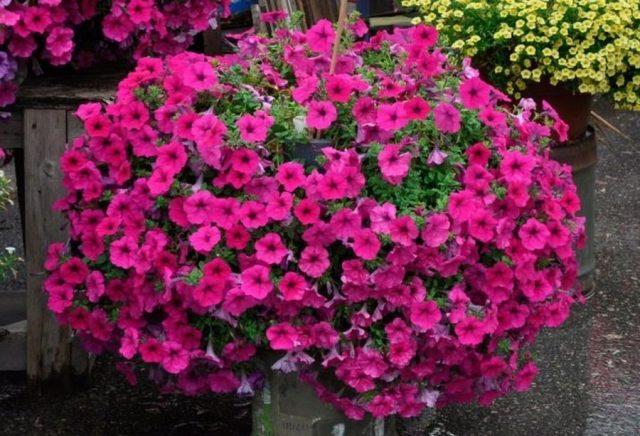
The height of the super cascade petunia Wave is about 15 cm
Growing super cascade petunia seedlings
The easiest way to grow super cascade petunia for your summer cottage is from seeds. It is only necessary to sow on time, and then provide comfortable conditions for the seedlings.
Landing dates
It is recommended to sow supercascade petunia for seedlings in the spring. The exact timing depends on the specific region. In most areas, the procedure is performed from mid-February to early March.
In the Urals and Siberia, sowing is usually postponed to the first days of April due to the late onset of spring. In the southern regions, planting can be done earlier than standard dates - in early February. In any case, you need to focus not only on the climate, but also on the weather conditions in a particular season.
Sowing seeds
To successfully plant supercascade petunia with seeds, you need to pay attention to the selection of containers and soil. Take a container for the culture that is wide, but not too deep, with sides of about 10 cm. Holes are made at the bottom to drain moisture.You should not use a large pot for seedlings - in this case it will be difficult to control the degree of soil moisture.
The substrate for supercascade petunia is made from a mixture of garden soil, peat and humus, taken in a 2:1:1 ratio. To increase the looseness of the soil, you can add a little river sand to it. Both the soil and the container must be disinfected with boiling water or a solution of potassium permanganate before planting.
Direct sowing of super cascade petunia for seedlings is done as follows:
- Fill the bottom of the container with drainage made of expanded clay, perlite or broken brick.
- Place nutritious soil on top, not reaching about 1.5 cm to the edges of the sides.
- Moisten the substrate with warm, clean water.
- Spread the seeds over the surface of the soil, straightening them with a toothpick or needle.
- Lightly press the material into the soil and re-moisten it with a sprayer.
Immediately after planting the seeds, the container must be covered with film and placed in a warm, illuminated place.

The optimal temperature for germinating super cascade petunia seeds is 23 °C
Seedling care
Caring for supercascade petunia seedlings is not particularly difficult. Before germination, the box with seeds is only ventilated for 20 minutes a day. After sprouts form, you need to remove the film and move the container to a well-lit place. It is advisable to reduce the room temperature to 18 °C.
When growing, the main attention is paid to moderate watering. The soil at the roots of the annual should always remain slightly moist. In this case, waterlogging of the soil should be avoided.If necessary, seedlings are illuminated with phytolamps, and the seedlings are also provided with access to fresh air.
When 3-4 true leaves appear, the sprouts of supercascade petunia need to be planted in individual containers. After another month, the procedure is repeated so that the roots of the culture can develop freely. A week after picking, the seedlings can be fed with complex minerals taken in minimal concentration.
Planting and care in open ground
It is necessary to replant supercascade petunia in open ground at the end of May or at the beginning of June. We need to wait until warm weather sets in and the night frosts end. On the site for the crop, choose a well-lit place with fertile soil; you must also take care of protection from strong winds.
A grown annual can be placed directly in the ground or taken outside in spacious 5-10 liter pots. In the first case, holes are prepared in the selected area, twice the size of the roots, and young bushes are carefully transferred into them. In one large container it is allowed to place up to three seedlings per 1 m2 in open ground - up to four plants.
Before planting in the garden, you need to organize hardening for the crop. To do this, containers with annual plants are taken outside every day for two weeks. First, they are left in the air for only half an hour, then for a full day.
When caring for crops on the site, you need to pay attention to several points:
- Watering. Super cascade petunia requires plenty of moisture. In hot weather, the plant should be watered at least twice a week. During periods of drought, moisturizing is allowed daily. You need to use settled lukewarm water for irrigation.The procedure is carried out only in the evening or in the morning, before the bright sun arrives at the site.
- Feeding. Every two weeks, it is recommended to fertilize supercascade petunia with liquid mineral compounds. The plant needs mainly potassium, magnesium and phosphorus; it requires almost no nitrogen for development. In addition to ready-made fertilizers, it is allowed to use organic matter - for example, a solution of bird droppings or mullein infusion.
- Topping. In order for super-cascade petunia to bush better, its shoots need to be shortened from time to time. The first time the procedure is carried out after the formation of the fifth true leaf. The very top of the stem, which has reached about 7 cm in length, is removed. After this, the supercascade petunia begins to more actively produce side shoots. It is recommended to repeat the procedure once a month.
- Loosening. When growing a crop, it is necessary to regularly stir up the soil at the roots to a shallow depth. The procedure improves oxygen saturation of the soil. At the same time, weeds that inhibit the development of supercascade petunia are removed.
With the onset of late autumn, the crop is usually completely removed from the site in order to re-sow it for seedlings the following year. In Russia, super-cascade petunia is grown as an annual plant - it is not able to survive the winter even with high-quality shelter.

During the flowering period of an annual, drying buds must be removed weekly to stimulate the appearance of new ones.
Conclusion
Petunia supercascade is a hardy ornamental plant represented by a large number of varieties.The annual plant quickly emerges from seeds when sown as seedlings, begins to bloom early and remains attractive until late autumn.
Reviews of super cascade petunia
